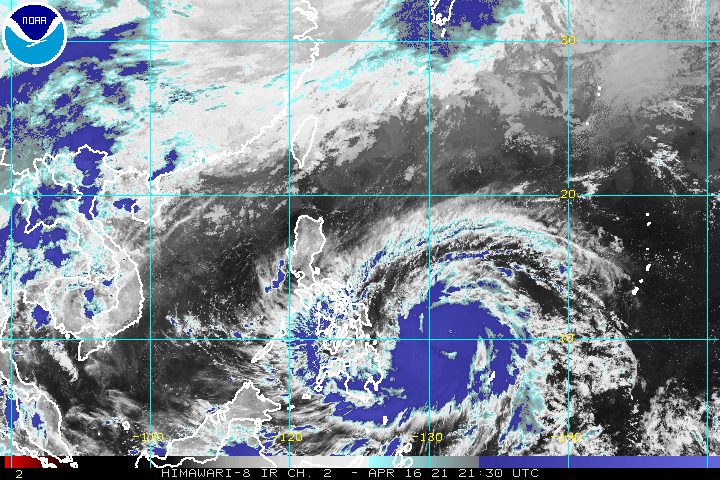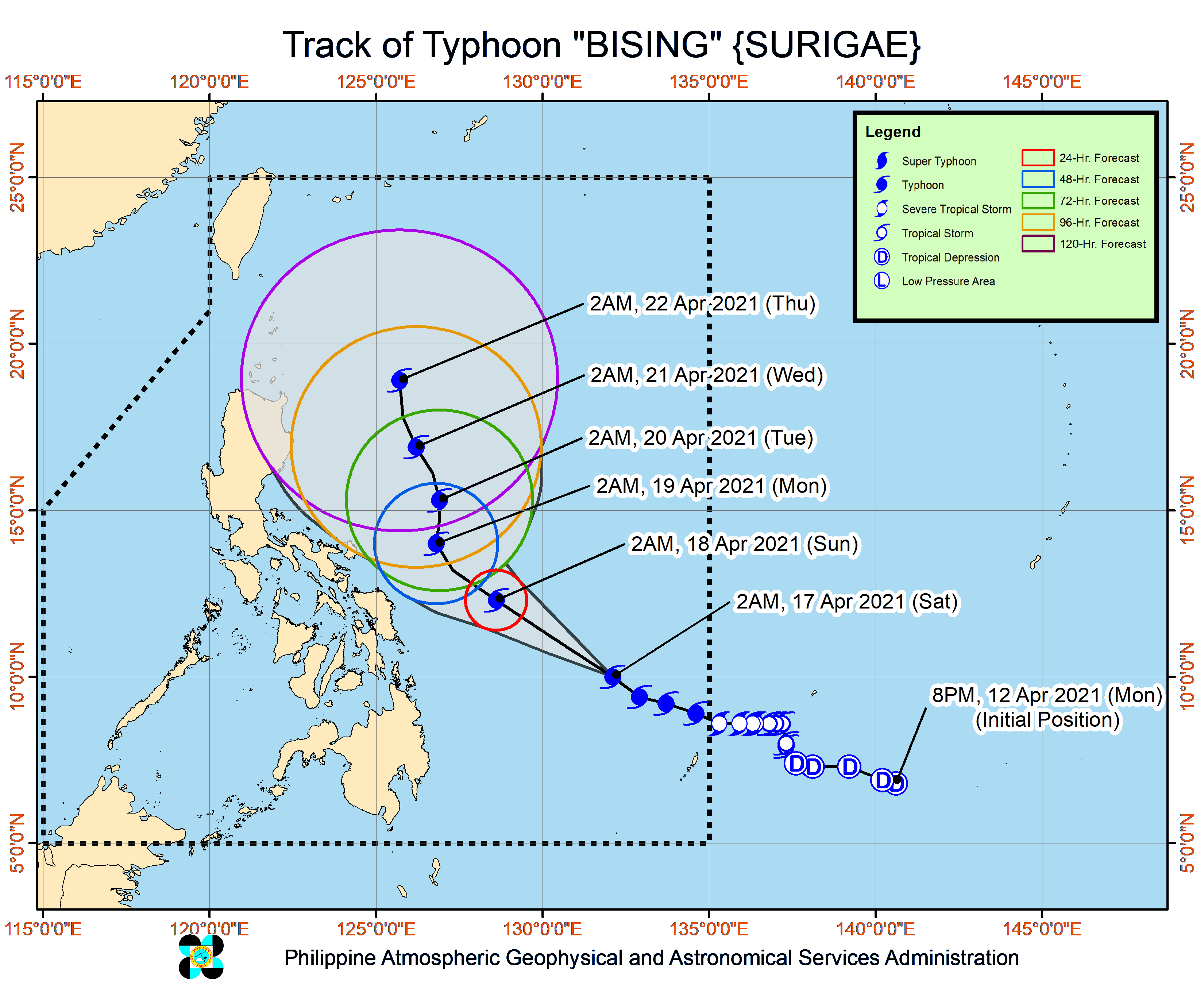SUMMARY
This is AI generated summarization, which may have errors. For context, always refer to the full article.

Typhoon Bising (Surigae) continued to rapidly intensify over the Philippine Sea before dawn on Saturday, April 17, with parts of the country told to brace for heavy rain the next day.
The Philippine Atmospheric, Geophysical, and Astronomical Services Administration (PAGASA) said in its 5 am bulletin on Saturday that Bising now has maximum sustained winds of 175 kilometers per hour (km/h) and gustiness of up to 215 km/h.
These are coming from maximum sustained winds of 150 km/h and gustiness of up to 185 km/h on Friday evening, April 16.
PAGASA now expects Bising’s peak intensity to be 195 to 205 km/h by Sunday, April 18. (READ: FAST FACTS: Tropical cyclones, rainfall advisories)
As of early Saturday, Bising was located 705 kilometers east of Surigao City, Surigao del Norte, or 775 kilometers east of Maasin City, Southern Leyte.
It slightly accelerated, moving west northwest at 20 km/h from the previous 15 km/h.
The typhoon will generally maintain a west northwest or northwest direction over the Philippine Sea until Sunday afternoon or evening, according to PAGASA.
Then it could slow down and move north or north northeast until early Tuesday morning, April 20, before moving north northwest over the Philippine Sea east of Northern Luzon and Central Luzon.
In that scenario where Bising would shift generally upward, it will not make landfall. But since it has a wide diameter, rain and winds from the typhoon are still expected to be felt in parts of the country.
PAGASA’s latest rainfall forecast shows Bising’s rainbands could trigger moderate to heavy rain, with at times intense rain, in these areas on Sunday:
- Eastern Visayas
- Sorsogon
- Masbate
- Albay
- Camarines Sur
- Catanduanes
- Camotes Islands
The state weather bureau warned that floods and landslides may occur.
In terms of winds, more areas have been added under Signal No. 1 as of 5 am on Saturday:
- central and eastern parts of Sorsogon (Castilla, Magallanes, Matnog, Juban, Irosin, Bulan, Santa Magdalena, Bulusan, Barcelona, Casiguran, Gubat, Prieto Diaz, Sorsogon City)
- eastern part of Albay (Manito, Legazpi City, Santo Domingo, Malilipot, Bacacay, Tabaco City, Rapu-Rapu, Malinaw, Tiwi)
- eastern part of Camarines Sur (Presentacion, Caramoan, Garchitorena)
- Catanduanes
- Northern Samar
- Samar
- Eastern Samar
- Biliran
- Leyte
- Southern Leyte
- Camotes Islands
- Dinagat Islands
- Surigao del Norte, including Siargao and Bucas Grande Islands
- Surigao del Sur
PAGASA said tropical cyclone winds that are “at least strong breeze to near gale in strength extend outward up to 550 kilometers” from Bising’s center.
“Destructive typhoon-force winds,” meanwhile, “extend outward up to 50 kilometers” from the center. Since Bising’s center is hundreds of kilometers away from land, these winds are not being felt.
PAGASA said the highest tropical cyclone wind signal that could be raised due to Bising is still expected to be Signal No. 2. But if the typhoon shifts more to the east or veers away from land, the wind signal could remain at just Signal No. 1. If it moves more to the west or toward the direction of land, wind signals could be higher than Signal No. 2.
As for coastal conditions, rough to very rough seas in the eastern seaboards of the areas below are being experienced on Saturday.
- Bicol (waves 2.5 to 4.5 meters high)
- Eastern Visayas (waves 2.5 to 6.5 meters high)
- Caraga (waves 2.5 to 5.5 meters high)
- Davao Region (waves 2.5 to 3 meters high)
Travel is risky for all types of vessels, warned PAGASA.

Bising is the Philippines’ second tropical cyclone for 2021. The country usually gets an average of 20 tropical cyclones each year. (READ: LIST: PAGASA’s names for tropical cyclones in 2021)
For the next 6 months, PAGASA estimates the following number of tropical cyclones inside the Philippine Area of Responsibility:
- April – 0 or 1
- May – 0 or 1
- June – 1 or 2
- July – 1 to 3
- August – 2 or 3
- September – 2 or 3
– Rappler.com
Add a comment
How does this make you feel?




There are no comments yet. Add your comment to start the conversation.